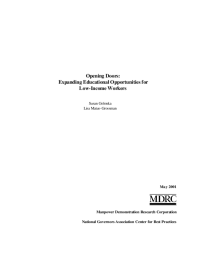Opening Doors: Expanding Educational Opportunities for Low-Income Workers
Since the passage of the Personal Responsibility and Work Opportunity Reconciliation Act in 1996, large numbers of welfare recipients have left welfare for employment. However, much of this employment is low-skilled and provides low pay. It is widely recognized that for welfare recipients and other low-income workers to advance in today's economy, they need to acquire technical skills or postsecondary credentials. While access to and participation in postsecondary education is key to the achievement of long-term self-sufficiency, traditional higher education programs are often ill-suited to working individuals with families.
Recognizing the importance of education and training to career advancement, a number of states, local agencies, and community colleges have adopted innovative program and policy strategies to encourage and support participation in postsecondary education. Recent welfare and workforce development reforms have presented new funding sources and partnerships, as well as some new rules regarding work requirements and participation in education programs.
Policymakers and program administrators at the state, local, and community college level can consider the following options to help welfare recipients and other low-wage workers receive additional education and training:
Under flexible federal welfare reform rules, states can allow welfare recipients and other low-income parents to participate in a combination of work and school, or school alone, while still meeting their work participation rates by
- altering work requirements to include college attendance and work-study placements as "work activities";
- using state maintenance-of-effort funding to suspend federal time limits for cash assistance recipients enrolled in postsecondary programs;
- using state maintenance-of-effort funding outside the Temporary Assistance for Needy Families (TANF) cash assistance programs to support low-income parents as full-time students; and
- applying TANF funds to create new forms of tuition assistance, short-term education or training programs, and on- or off-campus support services for low-income working families including current and former welfare recipients.
- States, individual public agencies, and colleges can develop new partnerships and coordinate funding streams to serve a broader population of low-income recipients by
- locating workforce development one-stop service centers and welfare agencies on college campuses, and
- strategically combining and leveraging funds to provide postsecondary education and training opportunities for "shared" clients.
States can use TANF or other funds to support colleges' efforts to redesign or develop curricula that allow low-income parents to combine work and school. Colleges can make their programs more responsive to working individuals by
- offering flexible scheduling and instruction at alternative sites (such as those of major employers);
- modularizing programs (in which longer degree programs have been "chunked" into shorter courses that result in credits and build to a credential);
- providing short-term, vocation-oriented programs that can be linked to career pathways and longer-term education and training options;
- granting credit for knowledge gained on the job or from prior learning experiences; and
- creating distance learning instruction.
Financial aid changes at local, state, and federal levels can expand access to postsecondary programs by
- creating new or revising existing need-based financial aid sources that cover part-time or non-degree postsecondary programs;
- combining state programs with aid from other sources (federal, institutional, and public agencies or the private sector) to provide a comprehensive package of support;
- working out agreements between the various aid sources to reduce overlap;
- offering rolling or additional federal Pell grant deadlines; and
- ensuring that state sources of financial aid do not impact eligibility for federal programs, such as Food Stamps and Medicaid.
Colleges can conduct aggressive outreach utilizing private sector marketing strategies and financial incentives to encourage low-income individuals to attend postsecondary programs. Other recruitment strategies include
- offering support services during college orientation or recruitment sessions;
- using current program participants as peer recruiters;
- partnering with other community organizations to expand recruitment efforts; and
- hosting on-campus activities (such as job club meetings), and including entire families during college recruitment or orientation programs, to overcome potential students' negative past educational experiences or apprehensions.
State and local agencies and community colleges can respond to the support service and financial needs of low-income working students in college programs by
- providing academic support services, including tutoring, training, learning disability assessment, and remedial programs that provide a bridge to academic or occupational offerings;
- offering child care, housing, transportation, and mentoring services and providing these supports during evenings and weekends, as well as on weekdays; and
- offering monetary or other incentives, directed at individuals or entire families, to help students complete their programs.
- States can require that colleges involve employers as a condition of receiving TANF funds for training programs, to ensure that these programs meet local labor needs. Other methods to encourage employer-college partnerships include
- offering incentives such as training for supervisors or other incumbent employees, and
- providing post-employment job retention services.
States can implement efforts to facilitate institutional or systemic change at the postsecondary level, including
- reforming college financing systems to create stable funding sources for innovative short-term training programs;
- exploring new sources of federal or state-level funding;
- developing collaborations between new partners for postsecondary programs; and
- ensuring that program rules and reporting requirements for multiple funding sources are not in conflict with one another.







